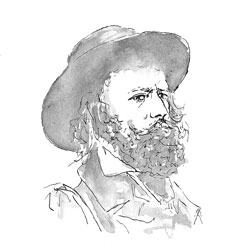Reading ‘Tears, idle tears’ (2): New Criticism, Cleanth Brooks, and Tennyson’s Ambiguity
Tears, idle tears, I know not what they mean,
Tears from the depth of some divine despair
Rise in the heart, and gather to the eyes,
In looking on the happy Autumn-fields,
And thinking of the days that are no more.Fresh as the first beam glittering on a sail,
That brings our friends up from the underworld,
Sad as the last which reddens over one
That sinks with all we love below the verge;
So sad, so fresh, the days that are no more.Ah, sad and strange as in dark summer dawns
The earliest pipe of half-awaken'd birds
To dying ears, when unto dying eyes
The casement slowly grows a glimmering square;
So sad, so strange, the days that are no more.Dear as remember'd kisses after death,
And sweet as those by hopeless fancy feign'd
On lips that are for others; deep as love,
Deep as first love, and wild with all regret;
O Death in Life, the days that are no more.
Very influenced by I.A. Richards' and F.R. Leavis' methods, the New Criticism movement formed a dominant strand of English and American literary criticism between the 1920s and early 1960s. Even more so than for Richards and Leavis, what mattered for New Critics like William Wimsatt and Monroe Beardsley were 'words on the page': New Critical readings demand exacting attention to works of literature, with particular attention being paid to the use of techniques like paradox, ambiguity, irony and tension, in order to discover what texts mean. Unlike Richards and Leavis however, the New Critics went so far as to imagine that literary texts function as autonomous entities, independent of the cultures that created them, such that many modern critics have criticised the movement on the grounds that its focus on words on the page necessarily involves a forced inattention to the context which produced and surrounded these words.
In stark contrast with Leavis, Cleanth Brooks praised 'Tears, idle tears' because he felt that it did contain enough complexity to convey an important message about the co-existence of contrary impulses within 'the Weeper's' character. After reading the following sentence from Brooks' account of the poem, in his book The Well-Wrought Urn, think about how his account might help you to appreciate the meaning of Tennyson's poem in a way that Leavis' did not: 'If this poem were a gentle melancholy reverie on the sweet sadness of the past', Brooks claims, then 'stanzas II and III would have no place in it'. Is there anything special about its second and third stanzas? Do they interrupt that 'sweetly plangent flow' which Leavis was writing about? What effect is created by the poet's repeated emphasis on objects and ideas that are 'sad' and 'strange'?
Brooks uses his close reading to support the idea that Tennyson's poem is not actually 'a gentle melancholy reverie':
The poem is no such reverie: the images from the past rise up with a strange clarity and sharpness that shock the speaker.
Notice here how Brooks ascribes 'a strange clarity and sharpness' to those same images which Leavis suggested were vague. What do you think about these images? Brooks continues:
The past should be tame, fettered, brought to heel; it is not... The word 'wild' in the final stanza is bold but not justified. It reasserts the line of development which has been maintained throughout the earlier stanzas: 'fresh', 'strange', and now 'wild' - all adjectives which suggest passionate, irrational life.
Already then, before we have begun considering how things outside the text might influence our appreciation of its meaning, we have come across two strongly opposed readings of 'Tears, idle tears'. According to Leavis the poem is simple; moreover, it is dangerous insofar as it lures us into acquiescing with its 'sweetly plangent flow'. According to Brooks the poem is complex; its initially 'gentle', melancholic and rationally reflective mood is interrupted in stanzas two and three, which contain an eruption of 'passionate, irrational life'. Which critic do you most agree with?
It is now time to focus on some factors beyond 'the words on the page', and to think about how these might help us to understand the poetry.
Click here to continue with this close reading of Tennyson's 'Tears, idle tears'.
